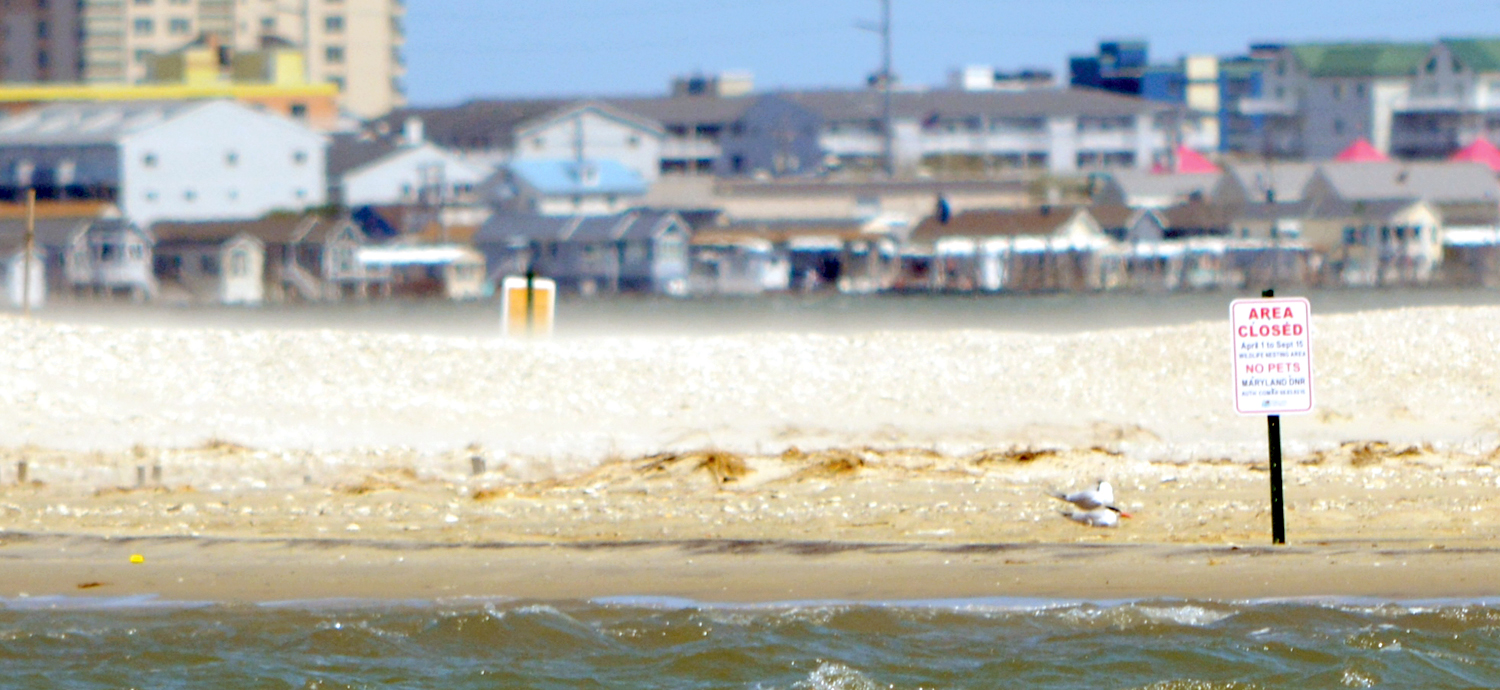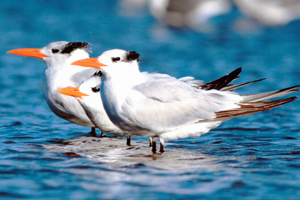Tern Island: This place is for the birds

Tern Island; staff photo
Barely rising above the waterline in Isle of Wight Bay is, perhaps, the last hope for some of Maryland’s beach-nesting birds.
A small, four-acre disk of sand, about a half a mile west of Ocean City, is where scientists and bird lovers hope black skimmers, royal terns and common terns will come each spring to breed and replenish their badly depleted numbers.
Tern Island, too new to appear on maps, was built last year by the U.S. Army Corps of Engineers in collaboration with the Maryland Coastal Bays Program and numerous agencies as a sanctuary for these endangered flyers.

Royal terns; by Kent Carlson
Addressing the need
Simply put, the future of these birds depends on undisturbed, isolated islands and the protection they provide from predators, such as foxes and raccoons. The bays behind Ocean City and Assateague are some of the few remaining places in the state these birds can breed.
But erosion and rising water have eaten away at coastal bay islands “at an alarming rate,” says David Brinker, an ecologist with the Department of Natural Resources.
In the past quarter century, more than 300 acres of islands have disappeared. Only three of the seabirds’ original 29 islands remain for breeding and nesting.
As a result, the black skimmer population in the coastal bays has declined from 87 pairs to just six pairs since 2000. Common terns have declined 86 percent and royal terns have declined by 60 percent since the early 1990s. All three species are now listed as endangered in Maryland.
Island creation
To reverse this decline, the Maryland Departments of the Environment and Natural Resources, the Army Corps of Engineers and other partners drew up a plan to use dredge material from shipping channel maintenance and other projects to restore the nesting islands.
A 2011 restoration project near Ocean City and Assateague proved successful in attracting not only skimmers and royal terns but also least terns and American oystercatchers.
However, when erosion continued to nibble away at even these rebuilt islands, project partners decided to build an entirely new island for seabirds in a more remote location, large enough to withstand the pounding of currents and storms.
The resulting work—begun in 2014—created Tern Island, now part of the Sinepuxent Bay Wildlife Management Area.
Proper use
The timing of completion, however, meant that Tern Island was not posted before the start of summer. The beach meant for birds became a magnet for boaters whose activities scared birds off their nests and attracted avian predators such as seagulls and crows.
This year is a different story. The Department of Natural Resources has placed signs along the shoreline, closing Tern Island along with Heron and OC Spoils and Skimmer (Bird) islands from April 1 to Sept. 15, when birds are nesting. Staff will monitor the islands and Natural Resources Police will enforce the restrictions.
 With the help of Audubon Maryland-DC and the Assateague Coastal Trust, an outreach campaign has been created to educate the public about the importance of colonial nesting birds. That message has been turned into posters by children in the Assateague Coastal Trust’s Coast Kids program that will be go up around Ocean City for millions of visitors to see this summer.
With the help of Audubon Maryland-DC and the Assateague Coastal Trust, an outreach campaign has been created to educate the public about the importance of colonial nesting birds. That message has been turned into posters by children in the Assateague Coastal Trust’s Coast Kids program that will be go up around Ocean City for millions of visitors to see this summer.
With cooperation from the public, Tern Island truly will be for the birds.
Article by Candy Thomson—Natural Resources Police public information officer.
Appears in Vol. 19, No. 3 of the Maryland Natural Resource magazine, summer 2016.


 1-888-373-7888
1-888-373-7888 233733
233733